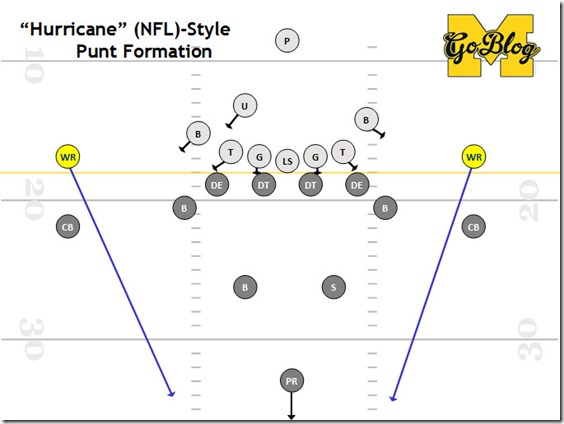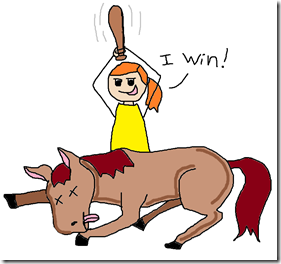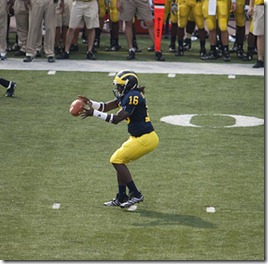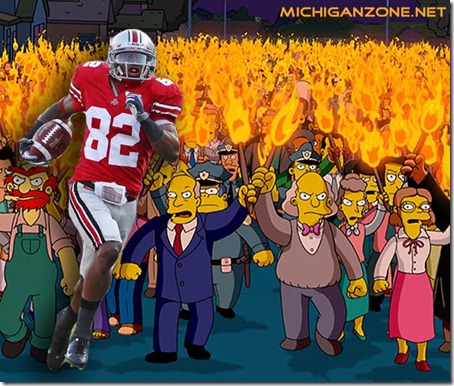beating dead horses real good
Takeaway: offenses were so potent by the 1950s that teams would punt on normal downs to gain field position, and the opponent wouldn’t have a guy ready for this.
Michigan’s outmoded punt formation is a horse we’ve been beating since Hoke’s first year despite it being about as dead as, well, NFL-style punt formations in college football. In light of last week’s punt-o-rama first half I got a question from a reader asking if we’d actually explain what the difference is between them and why one is better than the other.
So yeah, let’s do that, with the foreknowledge that Hoke isn’t going to change no matter what we say or prove; this is so you’ll know what you’re seeing only.
Here’s the punt formation that Michigan uses:
Like all things in football there’s a hundred different names and minor variations on it but the gist has remained the same since a time before the word “pattern” was replaced with “formation.” It follows the same rules as normal downs: seven men on the line of scrimmage, four in the backfield, with the backs plus ends on the line counted as eligible receivers. Since the snapper has to concentrate on that he typically doesn’t figure into the punt protection scheme except as a bonus dude to get in the way or cover a lane. The O-line does the front-line blocking, with a couple of wingbacks to protect against an edge rush and an up-back on the “leg” (…of the punter) side to catch anything that comes through, like an RB in pass pro, reading inside-out.
This protection scheme has worked for two generations and remains pretty safe from all kinds of punt blocking attacks unless a block is blown. It packs guys in the middle and on the outside the blockers mostly just have to keep rushers from getting inside before the punt is off. The two “ends” (wide receivers, really) are gunners, releasing downfield on the snap to attack the returner before the ball arrives and he can set up his blocking.
The NFL still uses this formation because they have to:
During a kick from scrimmage, only the end men, as eligible receivers on the line of scrimmage at the time of the snap, are permitted to go beyond the line before the ball is kicked.
Exception: An eligible receiver who, at the snap, is aligned or in motion behind the line and more than one yard outside the end man on his side of the line, clearly making him the outside receiver, replaces that end man as the player eligible to go downfield after the snap. All other members of the kicking team must remain at the line of scrimmage until the ball has been kicked.
Translation: only the two outside guys can be gunners; everyone else on the punting team can’t release downfield until ball leaves foot. This was an attempt to cut down on injuries, figuring it’s best to keep as many collisions between high-speed NFL bodies to short range meetings in the backfield.
[After the jump: niche opportunity leads to adaptation]
MGoBlog: where no sleeping dog is left to lie, and no dead horse is to remain unbeaten. -Blue in South Bend
left via
In re: shotgun + Denard + site obsession with Denard in shotgun, Football Study Hall put up a post with interception rates that highlights one of the many problems Michigan had turning yards into points last year: Denard's interception rate. Amongst a sample of 100 D-I quarterbacks* he finishes 84th. The only BCS quarterbacks to do worse were Garrett Gilbert, Stephen Garcia, Jeremiah Masoli, Steven Threet, BJ Daniels, and Jacory Harris. This is not good company. Harris and Garcia are 1-2 on this list…
THE ZESTY INTERCEPTION WATCH.
1. Jacory Harris. The nation's leader in zesty interceptions won't let being benched stop him. If it gets too bad with new boss Al Golden, he'll just go throw 'em in the street if he has to, because swag like Jacory's never sleeps, and when it does it lands wherever it wants.
2. Stephen Garcia. With confidence. With verve. With GARCIA.
…and the omission of BJ Daniels, who either throws an 87 yard touchdown or three interceptions every play, must have been an oversight thanks to South Florida's ability to fade into the background.
Denard's interceptions weren't zesty. They were like—and I say this in all seriousness—watching the cutest puppy in the world fly headlong into another puppy's head, killing both. The defense was like watching the puppy blood run into the gutter. This is the most precise analogy ever made. Also the field goal kicking was like watching the deceased puppies reanimate just so they could poop all over everything. The Rich Rodriguez era: defined.
SO, ANYWAY
Right. So forwards into the endless and admittedly pretty pointless discussion about the best thing to do for the team the next couple years when they have a 5'11" dreadlocked bolt of lightning at quarterback. My position is blindingly clear: Shotgun Today, Shotgun Tomorrow, Shotgun Forever. For the next two years, at least.
Objections raised from the comments largely revolve around the idea that last year's turnover and redzone performances were flukes that should be expected to magically repair themselves. An example:
I think its a pretty big reach to say there's any "evidence" to suggest that the offense will revert to the mean. College Football red zone offenses are not random occurrences within a normal population. Oregon and Auburn weren't so good in the red zone because they got randomly lucky. Michigan wasn't terrible because we weren't randomly unlucky.
The offense was terrible in the red zone because:
1) Nobody could make a FG longer than 25 yards (this isn't something that will revert until someone can kick the ball)
2) Our offense simply didn't work as well in the red zone (I don't know why---playcalling, B1G defenses, nerves, but it isn't something that happened because of random chance)
There is no guaranteed regression to the mean in nonrandom circumstances, like football. Michigan was terrible in the red zone because being terrible in the red zone WAS the mean for Michigan in 2010.
You hope #1 will be solved by the addition of Matt Wile. We are all gunshy about this but highly rated kickers—which Wile was by the end of the year—usually do well. That actually turns out to be irrelevant, about which see this long footnote**. The redzone issues come down to two things: turnovers, about which see above, and giving the ball back on downs.
Michigan did the latter four times last year, all of them late in already-decided games (one against Wisconsin and OSU, two against Mississippi State). They missed one field goal. They failed to score eleven more times because they straight-up turned the ball over.
As far as #2, the whole reason people do these study things and use stats is to have something to argue against people who use the word "simply" as their conversational gambit. Oh, it's simple to you, is it? Well, fine then. I guess you and your galaxy-spanning intellect win. It is possible that NFL football is so different than college football that studies do not cross over, but it is extremely unlikely, and that FO study showed really good redzone teams one year are almost precisely average the next.
In Michigan's case they should expect more than randomness to work in their favor. The common thread of Rich Rodriguez's tenure at Michigan was young or terrible quarterbacks. Three years of Threet/Sheridan, Forcier/Denard, Denard/Forcier should see you give away turnovers like they're candy. There are no upperclassmen on that list except the walk-on; there's only a few confused snaps from a hopelessly raw Denard preventing that list from having any sophomore starters.
The spread 'n' shred in general and Rodriguez in particular haven't shown they are turnover-prone. On the contrary, being able to run 70% of the time and have a good offense should cut down on turnovers since passes are inherently more risky.
From Maize 'n' Brew:
And that is what this comes down to. Common sense. Your eyes. If your eyes are telling you that you're watching a turd of a football game, well... you are. If your reaction to the Wisconsin Michigan game was that Michigan just got completely curb stomped by Wisconsin in the first half, mounted a minor comeback when Wisconsin took a third quarter nap, and then still got blown out by 20 points at home, well... that's what you saw. Perhaps the stats tell a different story. Maybe. But while the stats say that Michigan ran up an astounding 442 yards against Wisconsin they don't relate what actually happened at the game.
I try to back up my opinions with statistical evidence because the use of tools is the thing that separates bloggers and chimpanzees from other primates like newspaper columnists and sports talk radio hosts not on WTKA.
If you want to go on your gut, I can do that too: Michigan has a 5'11"-ish quarterback who ran for 1700 yards last year and an offensive line that's now 100% recruited to zone block all day. They don't really have a promising running back. I feel, like, not good, man, about Michigan in the I-form.
Or I could say that "common sense" suggests that Wisconsin was not trying to let Michigan score in the third quarter and that the overall results should be taken in appropriate context, but then we're back to feelings, man.
What Is The Core?
I just don't see how the spread offense is responsible for turnovers except insofar as it puts an erratic Denard Robinson on the field instead of a finely-polished artillery piece, and who wants to fix Michigan's issues by replacing Denard Robinson?
/crickets
/Munn Ice Arena
/people stapling each other's hands to their sides just in case they have a hand-raising seizure
Not having Denard drop back from center does not make his throwing mechanics worse. If anything it allows him to ignore a complicated facet of football—NFL coaches are constantly bitching that college quarterbacks no longer know how to execute a five-step drop—and focus on throwing it to the guy who's really open because you're not running the ball.
Meanwhile, the run game was kind of good last year despite having the worst set of tailbacks at Michigan since at least that year BJ Askew got half the carries. This is directly attributable to putting Robinson in a position to run, something an I-form doesn't.
There are quarterback draws and waggle plays, yes. Opponents will be all over them because those are constraint plays—not your base. Smart Football on how you build an offense:
The idea is that you have certain plays that always work on the whiteboard against the defense you hope to see — the pass play that always works against Cover 3, the run play that works against the 4-3 under without the linebackers cheating inside. Yes, it is what works on paper. But we don’t live in a perfect world: the “constraint” plays are designed to make sure you live in one that is as close as possible to the world you want, the world on the whiteboard.
Constraint plays thus work on defenders who cheat. For example, the safety might get tired of watching you break big runs up the middle, so he begins to cheat up. Now you call play-action and make him pay for his impatience. The outside linebackers cheat in for the same reason; to stop the run. Now you throw the bubble screen, run the bootleg passes to the flat, and make them pay for their impatience. Now the defensive ends begin rushing hard upfield; you trap, draw, and screen them to make them pay for getting out of position. If that defensive end played honest your tackle could block him; if he flies upfield he cannot. Constraint plays make them get back to basics. Once they get back to playing honest football, you go back to the whiteboard and beat them with your bread and butter.
The argument here is about the core of the offense: in the I-form that's Denard dropping back to pass or handing off to someone else. In the shotgun it's the zone running game. As the core of the offense you can't remove Denard from the game. You cheat and then there's a guy wide open. While Denard's legs are a terrifying constraint, Michigan has to force the opponent to cheat to use them.
I'll believe these tailbacks and this offensive line and this almost total lack of fullback and tight end can do that running power up the middle when I see it. If they can't you've just taken the most dangerous weapon in college football*** out of the game. You shouldn't do that. It's common sense.
------------------------------------------------------------------
*[I'm not sure why there were 100 quarterbacks instead of approximately 120 + a few injury replacements, so keep that in mind.]
**[Long aside on Michigan's historically awful field goal kicking goes here. Nonnair posted a diary asserting that the lack of field goal kicking was not a factor in red zone efficiency because Michigan actually scored more points than they could have if they kicked it:
The other seven fourth-down attempts I am dividing into two groups: (1) FG is the likeliest option and only a riverboat gambling coach or a team without a FG kicker would go for it, and (2) FG is only a possible option, either because it'd be very long, or because there was only 1 yard to gain for a first down so going for it is a viable option.
Bottom line? If we had tried FGs on all seven of those drives last year, even if we had Adam Vinatieri circa 2002 and he went 7-for-7, the most UM could have scored was 21 points.
As it was? UM got 27 points out of those drives. Six more points.
This is only one half of the equation, though, because Michigan did attempt a bunch of field goals and they went like this:

All that red in the Michigan zone is value earned by the offense that was lost by the kicker on obvious kicking opportunities. So on the field goals Michigan tried last year, we threw away 16 points, versus the six this study shows M getting back by being forced to do a statistically correct thing that teams don't usually do because their fans don't trust statistics.
Misopogon threw this behind a jump on Sunday.
Nonnair turns out to be right: the field goal kicking did not have much of an impact on the red zone efficiency because Michigan's misses are all clustered just outside. However, the statistically correct behavior Michigan engaged in also had no effect. Six of the seven attempts were outside the red zone and the one that was inside it, a fourth and one from the Penn State 13, was converted and led to a field goal anyway.
So we're down to just the massive turnovers. I hope this section has highlighted how goofy red zone efficiency is.]
***[Other than Charles Robinson.]
via MZone
Periodic Ohio State turdstorm UPDATE! Yesterday Eleven Warriors graciously posted that Maurice Clarett might be a troubled weirdo who tried to take down Ohio State after he got the boot, but at least he's a trying troubled weirdo and he's not all bad. This is a level of understanding I do not have with Tractor Traylor even after the guy died tragically.
11W's reward for this understanding is to have Ray Small go MoCo:
"We have apartments, car notes," he said. "So you got things like that and you look around and you're like, ‘Well I got (four) of them, I can sell one or two and get some money to pay this rent."
The wheeling and dealing didn't stop with rings. The best deals came from car dealerships, Small said.
"It was definitely the deals on the cars. I don't see why it's a big deal," said Small, who identified Jack Maxton Chevrolet as the players' main resource.
The Columbus Dispatch reported on May 7 that OSU was investigating more than 50 transactions between OSU athletes and their families and Jack Maxton Chevrolet or Auto Direct.
Representatives for Jack Maxton Chevrolet did not return repeated requests for comment.
NCAA rules prohibit student-athletes from benefiting from the sale of their merchandise. Small said he wasn't the only one.
"They have a lot (of dirt) on everybody," Small said, "cause everybody was doing it."
Man… Ray Small. That guy was in trouble from day one at OSU, threw regular public hissy-fits about it, and he wasn't even that good at football. If I was an Ohio State fan he would be in my circle of the damned. Their term for this rapidly expanding category that includes Kirk Herbstreit and (to the truly deranged) Chris Spielman is "Fake Buckeye."
You can add Mark "Club Trillion" Titus to that list after he posted there was definitely something "shady" going on with football players' cars, then followed it up with a rebuttal saying that he shouldn't get death threats because that's mean. Titus claims the shadiness was to the point where most students knew or should have known what was going on.
Meanwhile, the local news station is investigating the Gibson thing and while that transaction continues to get more complicated it's not getting proportionally more explicable:
10 Investigates [sic] found that Gibson had a trade-in. He traded in a 2003 Chevrolet Monte Carlo that BMV records showed he bought for $15,400 just seven months earlier.
But the dealership may have given him only $1,000 toward the trade-in, [instead] dropping the sales price of the car he was buying by a substantial amount.
10 Investigates [sic] has learned that's what Kniffin has told investigators with the BMV.
The trade-in business materializes as predicted; an explanation for how Thad Gibson scraped together enough money to buy two cars worth a total of 30k in less than a year is yet to be explained. Along The Oletangy responds to the investigation apparently clearing the transactions:
In any case, it doesn't matter what the BMV finds when they analyze Jack Maxton Chevrolet's tax forms as long as no special treatment was given to Ohio State football players.
It's obvious plenty of special treatment was provided, but where is the smoking gun?
Position paper on demolition of Ohio State program and whether it is good or bad. If Ohio State was going to fall apart by Notre Daming themselves with a series of coaching hires ranging from questionable to insane, that would be a thing to be conflicted about in the same way certain Ohio State fans are bored with a terrible Michigan team they're just going to blow out.
This is a different thing entirely since it suggests the fence Tressel legendarily put up around Ohio's borders is one based on massive NCAA noncompliance. Meanwhile, thanks in part to this (and in part to Michigan imploding) they've gone 9-1 and turned the Big Ten into their personal playground. If the NCAA finds proof of this massive noncompliance and OSU gets bombed into the stone age and is no longer any good, there's no conflict there. It's an unadulterated good. Michigan has been hypersensitive about this stuff since the Ed Martin Day Of Great Shame, and it's obvious their main rival hasn't. Putting that on even footing will help put the rivalry there if it doesn't swing it all the way back to the Cooper days, which fine by me.
Hot under the collar, part II. ESPN's Mike Fish, you may remember from the above-referenced Maurice Clarett bombing, has a new article. This is the header image:
Africa basketball charity, AAU player headed to Indiana, Tom Crean, Indiana AAU coach. This can't be good. Not pictured: involuntary adoption. Hooray Beilein.
Hey let's rehash this again. MZone noticed that I hadn't mentioned Lloyd Carr's election to the College Football Hall of Fame and asks why I hate Lloyd Carr, complete with requisite psychoanalysis and link to me being mad in the immediate aftermath of the Hoke hire when everyone was mad, something I've obviously backed away from in multiple column-length pieces since.
To defend myself: I don't take the CFHOF seriously. It just elected Deion Sanders. When Tom Curtis was elected it warranted about two sentences. For better or worse, I am totally uninterested in the charity work of rich people. I've also said my bit about Carr as Michigan's coach over and over again. Contrary to two-bit psychoanalysis it was not negative, or at least it was far less negative than many.
And I am pissed off at the hostility to change that's obvious every time any former Carr player says something about anything. We've got a program of Joe Morgans. I'm worried how that will manifest itself on the field. It's not hard to draw a contrast between what's gone down the last three years and what would have gone down if Bo was still around. Bo would have been on the warpath; he probably would have dropped by to scream at Rodriguez some. The impression we've gotten from every one of Carr's former players is that there is exactly one person responsible for Michigan's decline—Rich Rodriguez—and not only is that incorrect (Horror, DeBord, Tressel vs Carr) but it's detrimental to Michigan's future. If we got back to the days where every bowl opponent laughs at how predictable we are that will not be good.
(I don't think that's happening because Borges is a real live offensive coordinator and not a broken robot that only calls zone left. Hoke uber alles.)
Eyerolling reorg. Adam Wodon on the inevitable hockey realignment coming sounds like anyone talking about anything last year when talking about conference realignment:
It all starts with Notre Dame. (Well, it all started with Penn State and the Big Ten, but that's already happened.) Think about it — you're Notre Dame's president. Your sports teams all play in the Big East, or, in the case of football, is the most storied program in college sports. You fire up CHN's iPhone app one morning to check the hockey standings, and what do you see? You see Notre Dame competing against some MAC and D-II schools. You recoil. This is not what Notre Dame does. This is not what Notre Dame is.
That is not a knock on the other schools, it's just reality. There is no way that Notre Dame is staying put. That means that the CCHA is certain to lose its remaining powerhouse (from an institutional, NCAA-wide standpoint), and fall further to seven teams. That means the CCHA is in trouble, as a whole.
Maybe Wodon's got some inside chatter on this that he's refusing to mention in an effort to make his column as annoyingly speculative as possible, but this is the impetus for an elaborate reorganization scenario that sees Notre Dame move to Hockey East because they'd rather play Merrimack (seriously) than Ferris State.
Notre Dame is choosing between some games against BC and then a bunch of schools no one at Notre Dame has heard of plus flying for literally every road game and staying in the CCHA. While ND has money, are they going to spend it on that for no real benefit? And will Hockey East expand to an eleven teams just for the dubious benefits of having ND in the conference? Travel costs matter in hockey, the longest season in the NCAA, and no one is going to make enough money on an ND move to justify the increased costs even if "this is not what Notre Dame does." Yeesh.
Etc.: Daily reports on the lacrosse move. Barwis opening a local gym. Rothstein lays out the reasons Michigan lax can be competitive quickly. Big Ten Geeks on FCOA.





80